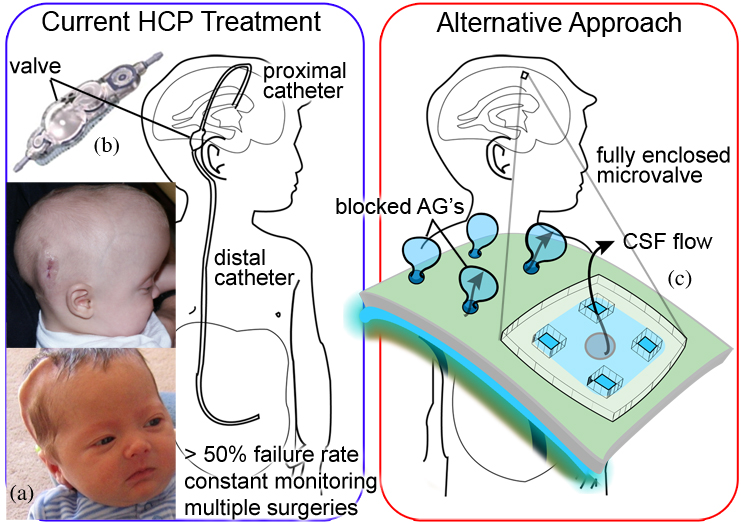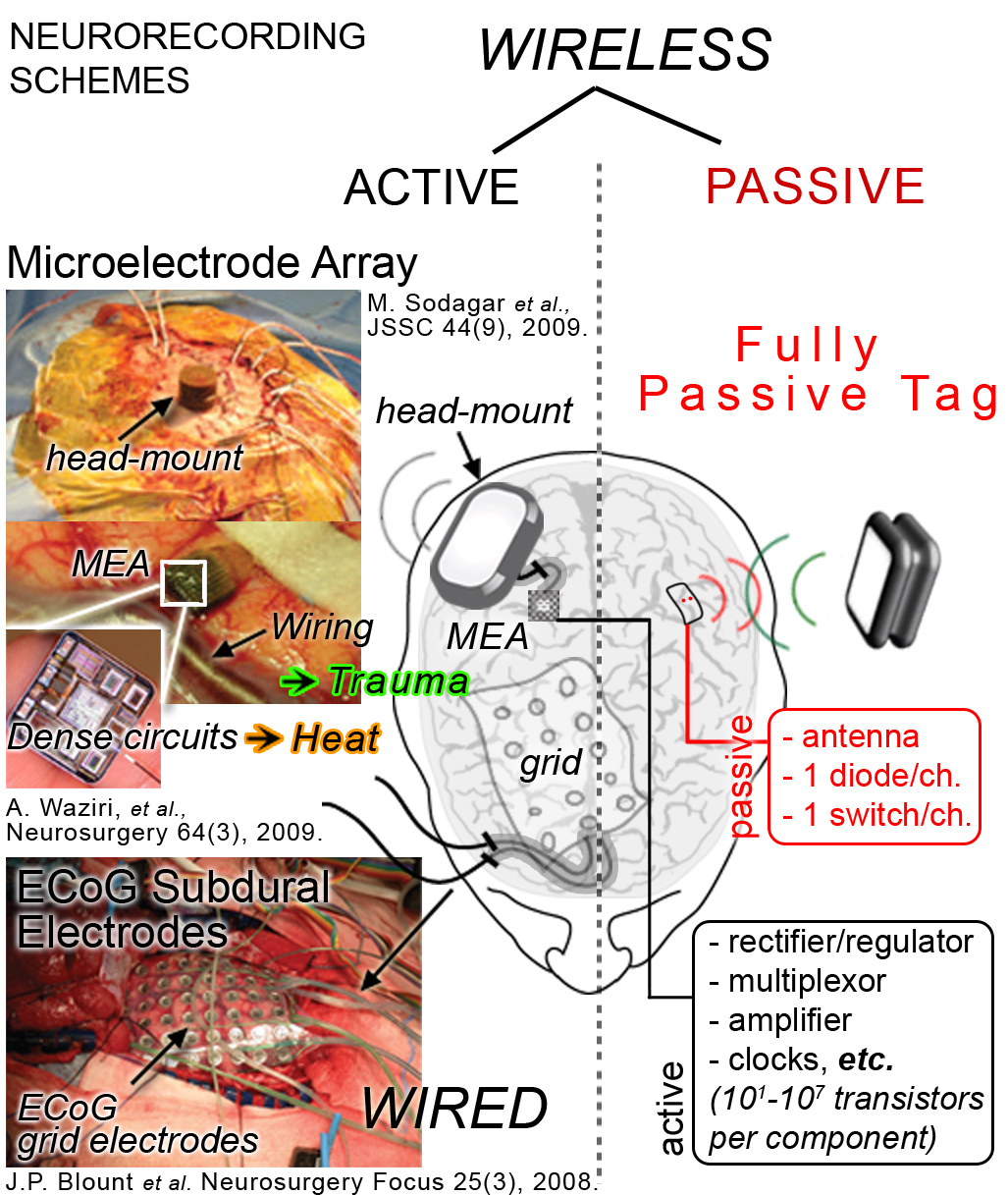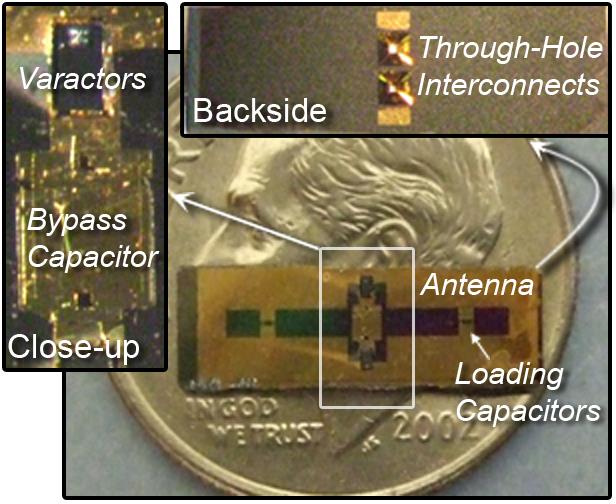My main (graduate) thesis research involves development of a fully passive wireless micro-tag for recording of brain-derived signals (ie. neuropotentials).
This system clears away from the traditional landscape of all standard electronics currently used to record neuropotentials and instead relies on the natural electrical characteristics of the brain signal to directly modulate incoming radar waves; this modulation (ie. backscatter) can be directly converted to the brain signal by an external wireless receiver.
Such a method strips away all digital/mixed-signal circuits (eg. >1 million transistor elements) inherent to most modern technology (inc. brain implants) and reduces the internal implant tag to a single modulating (nonlinear) element integrated with an onboard antenna.
fully passive wireless neuro-recording back to top
This microsystem-tag operates through entirely passive nonlinear mixing operations to record and wirelessly backscatter neuropotential brain signals. The on-chip mixer (nonlinear varactor element) directly mixes internal neuropotentials with the radar "carrier" signal (provided wirelessly from an external interrogator) to produce the backscatter signal, which carries the targeted brain-originated signals. This mixed harmonic signal is wirelessly backscattered directly back to the external interrogator where the original neuropotential can then be recovered and monitored.
Standard recording implants usually consist of dense VLSI micro-circuitry containing:
In the fully passive approach, all of the above are eliminated, and only a single diode & antenna are needed.
fully passive: no formal integrated power source/supply (eg. batteries, harvester, regulator, etc.)
neuro-recording: measuring bio-electrical signals produced by neurons (ie. neuropotentials) and transmitting this information for external monitoring
references:
H.N. Schwerdt, W. Xu, S. Shekhar, A. Abbaspour-Tamijani, B. Towe, F. Miranda, and J. Chae, “A Fully-Passive Wireless Microsystem for Recording of Neuropotentials using RF Backscattering Methods,” IEEE/ASME Journal of Microelectromechanical Systems, vol. 20, no. 5, pp.1119-1130, Oct. 2011.
[ link ]J.P. Blount, et al., Neurosurgery Focus 25(3), 1-8, 2008.
A. Waziri, et al., Neurosurgery 64(3), 540-545, 2009.
M. Sodagar, et al., IEEE Journal of Solid-State Circuits 44(9), 2591-2604, 2009.
hydrogel check valve for hydrocephalus treatmentback to top
Hydrocephalus ("water in the brain") is a disorder in which cerebrospinal fluid (CSF) cannot drain properly from the brain, leading to morbidly high intracranial pressures (ICP). Current standardized treatments involve bulky shunts (protracted valves and cathether tubing assembly) that are implanted into the brain and extend all the way to the stomach or other distal organs to carry excess CSF from the brain to these areas. However, work is underway to create safer and more secluded/concealed treatments. One way to improve treatment is to isolate draining mechanisms at the original site of the fault, the arachnoid granulations or the brain's natural valve formations that often become obstructed in hydrocephalus. Using microfabrication techniques, a small (~ µm to mm-scale) check valve can be readily installed at the site of blockage and constrain draining mechanisms within the skull (no bulky tubing). Unlike other miniaturized valves, the valve must be permanently stable against finite leakage and other possible failure mechanisms. To address permanent stability as a chronic lifelong implant, a simple and robust valve is desired. Here, the valve is made of only 2 materials (silicon and hydrogel) and is capable of providing a strong seal to prevent backflow leakage. Hydrogel is used in this valve to make use of its natural swelling properties that are used to enforce sealing against leakage.

( "AG": arachnoid granulation )
So far we have been able to show successful operation of the valve in bench-top experiments that confirm its realization of targeted fluidic characteristics in the range of normal human CSF draining operations and/or commercial shunts. The next step is to demonstrate its operation in vivo and its long term stability using semi-accelerated or extended tests in realistic hydrodynamic environments.
references:
H.N. Schwerdt, R. Bristol, and J. Chae, “ Miniaturized Passive Hydrogel Check Valve for Hydrocephalus Treatment,” IEEE Transactions on Biomedical Engineering, [available early access online—Nov. 2013].
[ link ]D.R. Nickolaus and L. Lintula, “Hydrocephalus therapy: living with hydrocephalus,” Medtronic Booklet, 2007.
other workback to top
¤ ongoing work — "fully" passive wireless multichannel neurorecording ¤
In Dr. Chae's lab, we are working on expanding the capabilities of the original single-channel fully passive neurorecorder to be able to record from multiple brain sites simultaneously. To avoid sacrificing the fully passive and simple qualities of the single-channel device, we integrate optical modalities, redeploying the electromagnetic band to the next useable spectrum. At these near-infrared wavelengths, passive optically selective switches can be incorporated on top of current passive recording operatiosn and will form the groundwork for building multi-channel switching capabilities.
¤ current / ongoing work — passive wireless implantable neuro-stimulation ¤
To further carry on the benefits of passive RFID-like methods to stimulating operations, designs and tests are underway to create simple implantable neural-stimulators in the same nature as the fully-passive recorder.

